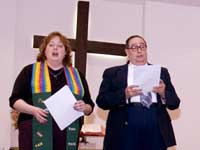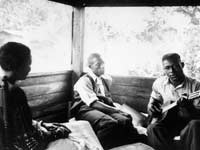Adele: Tiny Desk
22yo Brit, Adele has a new album, 21, and an Adele: Tiny Desk Concert : NPR.
22yo Brit, Adele has a new album, 21, and an Adele: Tiny Desk Concert : NPR.

![]() Hearing Voices from NPR®
Hearing Voices from NPR®
110 Mormon Fringe: Life with Latter Day Saints
Host: Barrett Golding of Hearing Voices
Airs week of: 2011-02-16
“Mormon Fringe” (52:00 mp3):
Polygamists, Polynesians, and Indian Israelites:
Mormons believe Native Americans are descendants of the ancient House of Israel. It’s a Mormon mission to bring them back to the Kingdom of God. So they brought children, mostly Navajo, from their reservation homes, and placed them in Mormon foster families across the West. From 1954 to 1996, more than 20,000 kids went through the Indian Student Placement Program. Producer Kate Davidson spent a year interviewing people about their experiences. Her story, edited by Deb George, ran on the Worlds of Difference series from Homeland Productions.
“Take the road toward the top secret army base. Go past Muskrat Spring until you get near Salt Mountain.” A statue of a Hawaiian chief overlooks the Utah desert, with a plaque reading: “Ua mau ke ea o ka aina i ka pono. Ua mau ke ea o ka aina i ka pono,” the motto of the kingdom of Hawaii: “The life of the land is perpetuated in righteousness.” A tale of two states, lost tribes, and the Polynesians of Skull Valley who named their town, Iosepa, after Joseph Smith III.
Members of the polygymous True and Living Church of Jesus Christ of Saints of the Last Days were excommunicated by The Church of Jesus Christ of Latter-day Saints, not for plural marriage, but because the TLC called the LDS elders the agents of Satan. Then the sect split again, over how many wives can be in a husband’s bed. Scott Carrier spends time in the Last Days of Manti, Utah. Produced for This American Life “Factions.”
 A global tour of J-based data-viz, from IBM Many Eyes to Brazil’s Infografio 2.0, Journalism in the Age of Data: “A video report on data visualization as a storytelling medium.”
A global tour of J-based data-viz, from IBM Many Eyes to Brazil’s Infografio 2.0, Journalism in the Age of Data: “A video report on data visualization as a storytelling medium.”
The annotated Flash chapters are best, but there’s also a 50min Vimeo video, a podcast series (.m4v), and an accessible set of YouTube vids. (Produced by Geoff McGhee during a Knight Journalism Fellowship.)
via FlowingData (“Basically, all the repeat offenders here on FlowingData are in this video talking about what they do best…”).
From Funny or Die, “Sarah Palin Media Addict”(starring Gina Gershon):
More FOD Gina Does Sarah:
Gina Gershon Strips Down Sarah Palin
NYTimes Lens blog has a great post on what to bring and “What Not to Bring to Tahrir Square: Stephen Farrell Learns to Pack a Smaller Camera Kit.”
CAIRO — It is rare that the most important piece of equipment in your bag is the bag itself, even more rare for that bag to be a black plastic trash sack slung over your shoulder as you walk past pro-government thugs on a bridge over the River Nile. The trash bag’s purpose, of course, is to conceal your large nylon camera bag, which is likely to get you grabbed off the street by the aforementioned thugs.
Sometimes the hardest part of a story is getting there. Sometimes it is getting around. Sometimes it is obstructive intelligence agencies and soldiers. Sometimes it is lawlessness, sometimes overattentive law enforcement. Sometimes it is lack of transport, poor communications, power blackouts, accreditation difficulties or a hostile local population.
Though my colleagues and I have worked in far more dangerous places and under far more primitive conditions, I don’t think I’ve ever before covered a story in which all the above-mentioned obstacles were present and taking turns on a daily — sometimes hourly — basis to become the principal barrier to getting the journalist in and the story out.
Jake’s in Bangkok and snapping away…


 CPB’s Ted Coltman sent some pubcasting audience/contributer figures to the Pubradio maillist. It’s the first time I saw this data so concisely assembled. So, with his permission:
CPB’s Ted Coltman sent some pubcasting audience/contributer figures to the Pubradio maillist. It’s the first time I saw this data so concisely assembled. So, with his permission:
In FY 2009, TV and radio station grantees reported to CPB (on their Annual Financial Reports) a total of 5.6 million individual contributors (either to stations or to their associated “Friends” groups). There is undoubtedly some double-counting of individuals in that number (because some individuals give to more than one station), but CPB has no way of “de-duping” these data.
In validating a rule-of-thumb such as “only about one listener in 10 is a member/contributor,” it makes a big difference whom you count as a “listener” — anyone, for example, who listens at least once a month?… or only someone who listens at least once a week?
Public radio’s weekly cume audience is about 30.6 million persons, so the roughly 2.5 million contributors reported by public radio stations would be about 8 percent of the weekly cume listeners (roughly 1 in 12). Its monthly cume audience is estimated at about 64.7 million persons, so the reported contributors would represent about 4 percent of the monthly cume listeners (about 1 in 25).
Similarly, public television’s weekly cume audience is about 60.4 million persons, so the roughly 3.2 million contributors reported by public TV stations would be about 5 percent of the weekly cume viewers (1 in 20). And public TV’s monthly cume audience is about 121.9 million persons, so the reported contributors would constitute about 2.6 percent of the monthly cume audience (1 in 40).
Of course, the “unit of giving” is often a family or household, and the “units of listening or viewing” I just cited are individual persons (aged 12+ in the case of radio, or 2+ in the case of TV), so these ratios shouldn’t be considered very precise or reliable… but then neither are most “rules of thumb.”
Data sources: CPB’s ISIS database, RRC, Arbitron, PBS Research, Nielsen.
See 170 Million Americans for Public Broadcasting: The Numbers.
A few songs from Montreal.ca band Stars, beside the All Songs Considered Tiny Desk:
 Please pile on and join in the free4all-clusterfuq of commenting my “Killing Content” conspiratorial raving has incited over at the Transom: Sidebar.
Please pile on and join in the free4all-clusterfuq of commenting my “Killing Content” conspiratorial raving has incited over at the Transom: Sidebar.

![]() Hearing Voices from NPR®
Hearing Voices from NPR®
109 Musical Memory: The Soundtrack of Our Lives
Host: Barrett Golding of Hearing Voices
Airs week of: 2011-02-02
“Musical Memory” (52:00 mp3):
Selections from Musicians in their own words, from the series Song & Memory (What one song do you remember most from your childhood?), and from the Afterquake project:
Song & Memory: Rebel Chef Anthony Bourdain is known for his raucous ways in the world of the professional kitchen, detailed in his book “Kitchen Confidential.” We asked him to put away his pans and think back to when he was a kid — is there a song from childhood that brings it all back? Bourdain can pinpoint his desire sex-drug-rock n’ roll start to a single song: “96 Tears” by ? and the Mysterians. (The Song & Memory series was produced for PRI Weekend America.)
Musicians in their own words: Trudy Pitts and her husband, drummer Bill “Mr C.” Carney do a first-person duet. Trudy is an unsung hero of the Hammond B-3 electric organ. With her husband, Mr C, they’ve played with the Lionel Hampton, Clark Terry and Pat Martino. Their 50s R&B band, the Hi-Tones, featured a young sax player: name of John Coltrane. Their most rewarding musical partnership, though, is the one they share with each other. (MITOW stories were produced for NPR and are archived at PRX)
I’ve been Best Coast (space) crazy of late. Now the band has finally scrapped enuf shekels together for some videos.
From their 2010 debut album Crazy for You:
“One morning I watched a man named Jack LaLanne on TV who was teaching exercises and gymnastics. I decided to follow his exercies every morning and soon felt like a different person.”– Bette Davis
Exercise evangelist Francois Henri “Jack” LaLanne, September 26, 1914 – January 23, 2011. From AOLNews, “Jack LaLanne’s 10 Strangest Stunts:”
In 1955, LaLanne swam 1.23 miles from Alcatraz Island to Fisherman’s Wharf in San Francisco while handcuffed. He later told an interviewer that the worst part about the ordeal was not being able to do jumping jacks during the swim.
In 1974, LaLanne turned 60, but he showed the world that, for him, age was just a number by once again swimming from Alcatraz Island to Fisherman’s Wharf. However, this time, he was not only handcuffed but also shackled. Oh, and he towed a 1,000-pound boat.
LaLanne’s last public stunt was in 1994, when he celebrated his 80th birthday by getting handcuffed and shackled in order to fight strong winds and currents and swim 1.5 miles while towing 80 boats with 80 people from the Queensway Bay Bridge in the Long Beach Harbor to the Queen Mary.
 Piano: John Lennon “Imagine”
Piano: John Lennon “Imagine”
Acapella: Van Halen “Jump”
Mashup:Â Mighty Mike.
“Imagine a Jump” (2:17 mp3):
via Joe Bass.

![]() Hearing Voices from NPR®
Hearing Voices from NPR®
108 Making Music: For a Living, For a Life
Host: Barrett Golding of Hearing Voices
Airs week of: 2011-01-19
“Making Music” (52:00 mp3):
Making music, for a living, for a life:
The Maddox Bros. & Rose were America’s Most Colorful Hillbilly Band. In the 1930s, 40s & 50s, the four brothers and sister/singer Rose paraded thru America in their colorful Cadillacs and cowboy outfits. “Their costumes make Liberace look like a plucked chicken,” said Tennisee Ernie Ford.
Born to sharecroppers in Boaz, Alabama, they rode the rails and hitch hiked to California in 1933, where they formed the band. Their sound was both old-timey and western swing; their rhythms helped plant the roots of rockabilly. Ginna Allison’s sound-portrait features interviews with Rose Maddox, Tennesse Ernie Ford, Cliffie Stone, and her co-prodcuer on this piece, TJ Meekins of KVMR-Nevada City CA. (Images: Maddox Bros. & Rose: Myspace, Rockin’ County Style)
A preacher’s son, met in a North Carolina thrift shop, comes over the house to play guitar, and talk Jesus, G chords, and Gilligan’s Island. Carmen’s grandmother would not approve. Produced by Jay Allison for This American Life (PRX).
[UPDATE: Added Paul Rose’s memorial song.]
Lost another friend and great keyboardist, Dave Arnott (Band Universal and & Triumphant, FOG ) died at 49yo.
One early 1980s night, I was leaving KGLT about 3am, and this wild, ethereal piano was echoing up the stone stairwell. Odd, since the building had been closed for hours. Tracked it down to the grand in the 1st floor lounge, being played by one very serious and very accomplished young man. I introduced myself, so did he: Dave Arnott.
He was (as I recall) on a break from helping sound-wire the Student Union Theatre. I sat and listened. He played another half-hour.
I’ve seen some of this land’s best musicians of many genres in excellent venues across USA. But that pre-dawn Dave solo performance, to an audience that had just increased from 0 to 1, was among the most memorable concerts I’ve ever attended.
Music (“Yellow Jacket” by FOG from Rain) and Footage by David Arnott. Edited by Tol. Additional Footage by Tol, Blue, and Mike. More…
We have an exclusive pic of the new Verizon iPhone. Regarding the “death grip” dropped-call problem, Verizon’s Chief of Antenna Design announced, “We’re taking no chances”:

via Stonetip.
Democracy is the peaceful passing of power, as exemplified by this Jimmy Kimmel clip:
And what’s with Boehner’s Big Gavel?
Great new tune by my ol’ bud Bill McClintock, “Dollar Store”:
I bought a wrench & a saw & a screwdriver too, deluxe corkscrew & a jug of shampoo. A new dog dish for my pup, a baseball cap & a coffee cup.
I bought a flashlight & a safety knife, a can of corn & a real cool kite. I bought a faucet drain & a picture frame, a pair of dice & a can of Raid.
I bought some Saniflush & a new toothbrush, some Christmas cards & a tape by Rush…that fine Canadian band.
The aughts are over, now start the… teens? HV wishes your a hearty 1/1/11 welcome.
“I am going to make it through this year if it kills me.”
—The Mountain Goats, from The Sunset Tree, “This Year” (3:52 mp3):
Found at HuffPo’s “RIP Captain Beefheart,” CB, aka Don Van Vliet, talks w/ Dick Clark on American Bandstand, June 18, 1966:
And this advice the Cap’n gave his guitarist in the mid-90s (printed in Rolling Stone’s Alt-Rock-A-Rama):
THE TEN COMMANDMENTS OF GUITAR PLAYING as given to moris tepper by captain beefheart. they are not arranged hierarchically – each commandment has equal import. also, to help clarify their intent, each commandment is followed by an exegesis. More…